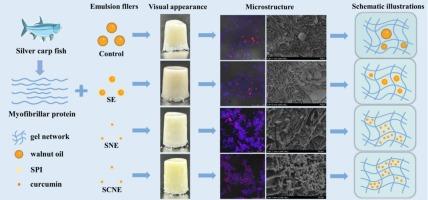基于大豆蛋白的纳米乳液填料的液滴大小和表面疏水性对鲢鱼肌纤维蛋白凝胶质量的影响
IF 6.5
1区 农林科学
Q1 CHEMISTRY, APPLIED
引用次数: 0
摘要
本研究探讨了当水包油(O/W)乳液作为肌纤蛋白(MP)凝胶的填充物时,液滴大小和乳化剂润湿性对凝胶特性的影响机制。使用大豆分离蛋白(SPI)和 SPI-姜黄素纳米颗粒制备了不同液滴大小的皮克林乳液,然后用于构建复合凝胶。研究结果表明,液滴尺寸的减小和乳化剂表面疏水性的增加增强了凝胶中的疏水相互作用,增加了 MP 分子的 β-片状含量。引入 SPI-Cur-NPs 稳定纳米乳液(SCNE)后,凝胶中的疏水作用力比对照组显著增加了约 2.6 倍,β-片含量也增加到 16.51%。此外,SCNE 的添加还改善了凝胶的抗氧化性能,使羰基和过氧化物含量分别降至对照组的 31.82% 和 24.15%。这些发现为改进基于 MP 的凝胶产品提供了启示。本文章由计算机程序翻译,如有差异,请以英文原文为准。

Influence of droplet size and surface hydrophobicity of soybean protein-based nanoemulsion fillers on the quality of silver carp myofibrillar protein gels
This study investigated the mechanisms underlying the influence of droplet size and emulsifier wettability on gel properties when oil-in-water (O/W) emulsions serve as fillers in myofibrillar protein (MP) gels. Pickering emulsions with varying droplet sizes were prepared using soybean protein isolate (SPI) and SPI-curcumin nanoparticles, then used to construct composite gels. Findings showed that decreased droplet size and increased emulsifier surface hydrophobicity enhanced hydrophobic interactions in the gel, increasing the β-sheet content of MP molecules. Upon the introduction of SPI-Cur-NPs stabilized nanoemulsion (SCNE), the hydrophobic force in the gel was approximately 2.6-fold more remarkable than that of the control, and the β-sheet content increased to 16.51 %. This resulted in a denser mesh framework and more uniform oil droplet distribution, increasing the hardness value from 26.993 g to 41.847 g. Moreover, SCNE addition improved gel antioxidant properties, reducing carbonyl and peroxide levels to 31.82 % and 24.15 % of the control, respectively. These findings offer insights for improving MP-based gel products.
求助全文
通过发布文献求助,成功后即可免费获取论文全文。
去求助
来源期刊

Food Chemistry: X
CHEMISTRY, APPLIED-
CiteScore
4.90
自引率
6.60%
发文量
315
审稿时长
55 days
期刊介绍:
Food Chemistry: X, one of three Open Access companion journals to Food Chemistry, follows the same aims, scope, and peer-review process. It focuses on papers advancing food and biochemistry or analytical methods, prioritizing research novelty. Manuscript evaluation considers novelty, scientific rigor, field advancement, and reader interest. Excluded are studies on food molecular sciences or disease cure/prevention. Topics include food component chemistry, bioactives, processing effects, additives, contaminants, and analytical methods. The journal welcome Analytical Papers addressing food microbiology, sensory aspects, and more, emphasizing new methods with robust validation and applicability to diverse foods or regions.
 求助内容:
求助内容: 应助结果提醒方式:
应助结果提醒方式:


